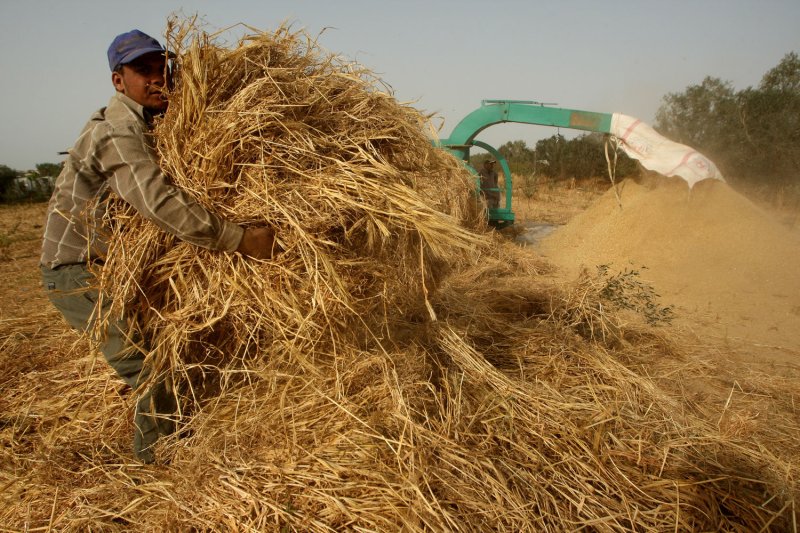Palestinian farmers grind load a combine harvester with wheat. File Photo by Ismael Mohamad/ UPI |
License Photo
Jan. 7 (UPI) -- World food prices hit a three-year high in 2020, a U.N. food agency said Thursday.
The United Nations Food and Agriculture Organization Index averaged 97.9 points in 2020, a 3.1% increase from 95 points in 2019, and the highest since it averaged 98 points in 2017, a U.N. FAO press release shows.
The FAO noted that the three-year high is still well below its peak of 131.9 points in 2011.
In December, the index, which tracks monthly changes in the international prices of commonly-traded food commodities, averaged 107.5 points, after increasing for the seventh straight month.
The index shows vegetable oil prices and cereal prices largely accounted for the increase.
The cereal prices were up 6.6% from 2019, and marked a the highest annual average since 2014 amid "tighter supplies and stronger demand," for wheat and maize, the FAO said in the release.
In particular, the six-year high came amid drought that threatened crops across South America and increased demand from China.
Bloomberg reported that prices are likely to keep rising in 2021, and consumers whose incomes have been impacted by the COVID-19 pandemic are especially hard hit.
"We do at this point see more factors pushing up global food prices," Abdolreza Abbasian, a senior economist at the FAO told Bloomberg. "While people have lost income, they are as we speak going through a tremendously difficult hardship."
The vegetable oil price index alone rose by 4.7% from the previous month to average 127.6 points in December, the highest level since September 2012.
"December's continued strength was mainly driven by firming palm oil values, while those of soy, rapeseed and sunflower seed oil also increased," the FAO said in the release.
The increase in palm oil prices was mainly due to "supply tightness in major producing countries," according to the release.
"In addition, export flows were affected by a sharp increase in export duties in Indonesia, the world's leading palm oil supplier," the FAO added.
"As for soy oil, international prices reached seven-year highs, mainly on account of reduced export availabilities in Argentina, where prolonged strikes affected crushings and port logistics."
Argentina farmers planned a protest strike after the government suspended corn-export licenses.
For the year, the vegetable oil price index rose 19.1% from 2019 to average 99.1 points.
The dairy price was up 3.2% in December, but was down 1% for the year as a whole.
Dairy prices rose in December largely due to concerns over adverse impacts of drier weather conditions on Oceania's milk production, according to the FAO.
Meat prices also rose in December 1.7% with increased import demand, but were down 4.5% for the year as a whole.
Sugar prices actually retreated slightly in December from a marked increase in November, but overall sugar prices were up 1.1% from last year. Indonesia has reported increased sugar demand, but increased production in Brazil, the world's largest producer, and India, have offset increases in prices.















